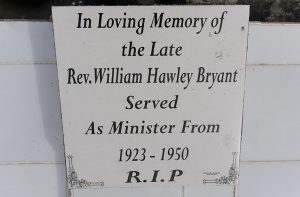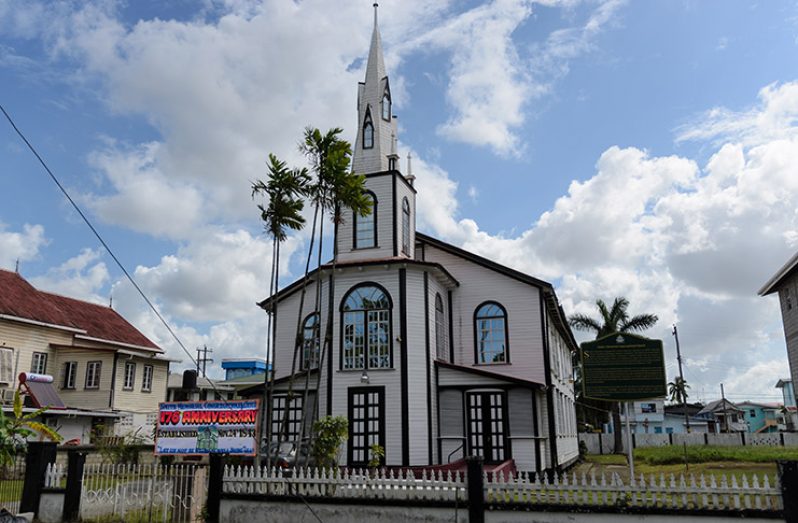VISUALLY attractive, but in a quaint way, stands Smith Memorial Congregational Church on the green lawns of the parish situated on the south-eastern shoulder of Brickdam, Georgetown.
The church is regarded as a heritage site by the National Trust of Guyana. The iconic wooden building was erected on November 23, 1843 in memory of Reverend John Smith, a London Missionary Society Minister. It was exactly 20 years after Reverend Smith was sentenced to death by hanging for the role he allegedly played in the notorious Demerara Slave Rebellion of 1823.
**On Sunday, November 24, 2019 and in observance of the church’s 176th Anniversary this month, a `celebratory’ service starting at 09:00hrs and being held under the theme “Let us not be weary in well doing- Gal.6:9”, will mark the occasion. Delivering the feature anniversary sermon will be Pastor Loris Heywood.
Smith died on February 16, 1824 while a prisoner on death row and waiting to be sent to England for a review of his trial. He was buried at a small cemetery just west of St. Phillip’s Anglican Church. He was subsequently referred to as the `Demerara Martyr’, due to the circumstances surrounding his death.
Smith had arrived in Demerara in February 1817 to succeed the Reverend John Wray, a pioneer missionary of the London Missionary Society at Bethel Chapel, Le Ressouvenir, East Coast Demerara (ECD). According to the records, like his predecessor Wray, he gave instructions to the slaves and also disobeyed the rules of the slave owners and taught their slaves to read the Bible and Catechism, thus laying the foundation of schooling and elementary primary education for the congregations.
Quamina, a slave, was a senior deacon at Bethel Chapel, and his son, Jack Gladstone, and other slaves were put to death for the role they allegedly played during the 1823 uprising, which had as its goal the freeing of the slaves.
Subsequent to the church building, and in tribute to the work and suffering Rev. Smith had to endure on behalf of his deacons, members and other followers, a bronze bust was prominently mounted and decorated the forecourt of the church’s lawns for many years. It was stolen during the 1990s and never found.

Retired High Court Judge Oslen Small, the presiding pastor at Smith Memorial Congregational Church, in an interview with the Guyana Chronicle said that unlike last year when the church celebrated the 175th Anniversary with pomp and ceremony, the observance this year is ‘toned down’. He related some of the inspiring history of the church from its inception, which was during the period of slavery in the Guianas and elsewhere in the Western Hemisphere. Those were the days when the English, Scots, Irish and others of Faith left family, friends and country, and travelled on ships for weeks, south-west across the Atlantic ocean, to the South American colony to spread the gospel.
Several commemorative plaques are prominently displayed on the walls of the church, including for: Reverend Edwin A. Wallbridge, who was born on the Isle of Wright on April 10, 1813. He founded the church and worshiped at and presided over it for 34 years; Frederick T. Wills, a retired General Medical Officer (GMO) who was at one time the Chairman of British Guiana Congregational Union (Nov.13, 1968 – May 02, 1943); Jane Wallbridge, widow of the founder and pastor; Margaret Glen Mackinlay, wife of Rev. John Currie; Hadel Fitzpatrick White, who died by drowning in the Waini River (May 17, 1922 – Dec 20, 1950); and James MacFarlane Curry, a member of the civil service who was born on March 7, 1924 and died at age 74. There is too, a photograph of Reverend Una Matthews (1911 – 2000), the first female chair of the Congregational Union.
In the forecourt of the church is a refurbished tomb of the Englishman Hawley Bryan, who spent many years in British Guiana, an educator and composer of one of Guyana’s patriotic songs, “Song of Guyana’s Children”. According to Rev. Small, the final resting place of the late Rev. Bryan was enhanced with tile as a gift to the church by Chief Fire Officer Marlon Gentle.
Meanwhile, a concrete edifice replacing the old wooden manse which was a feature at the said spot for years, just west of the church, is in its final stage of construction.



.jpg)








